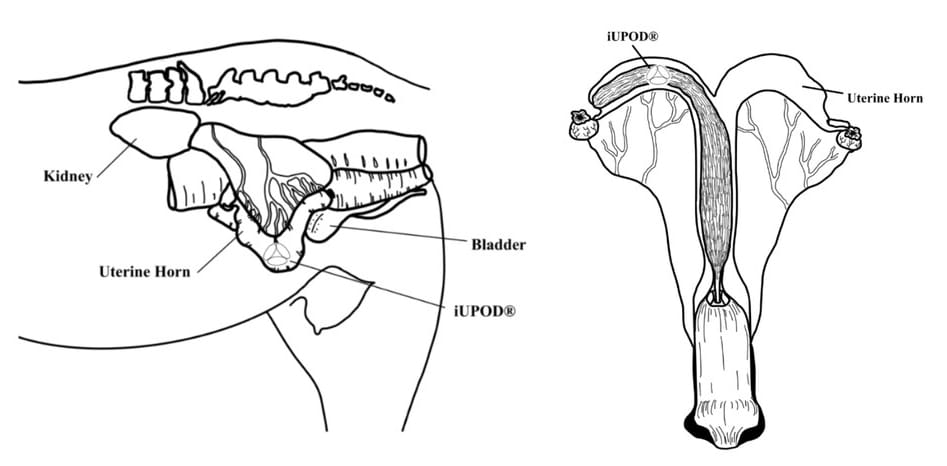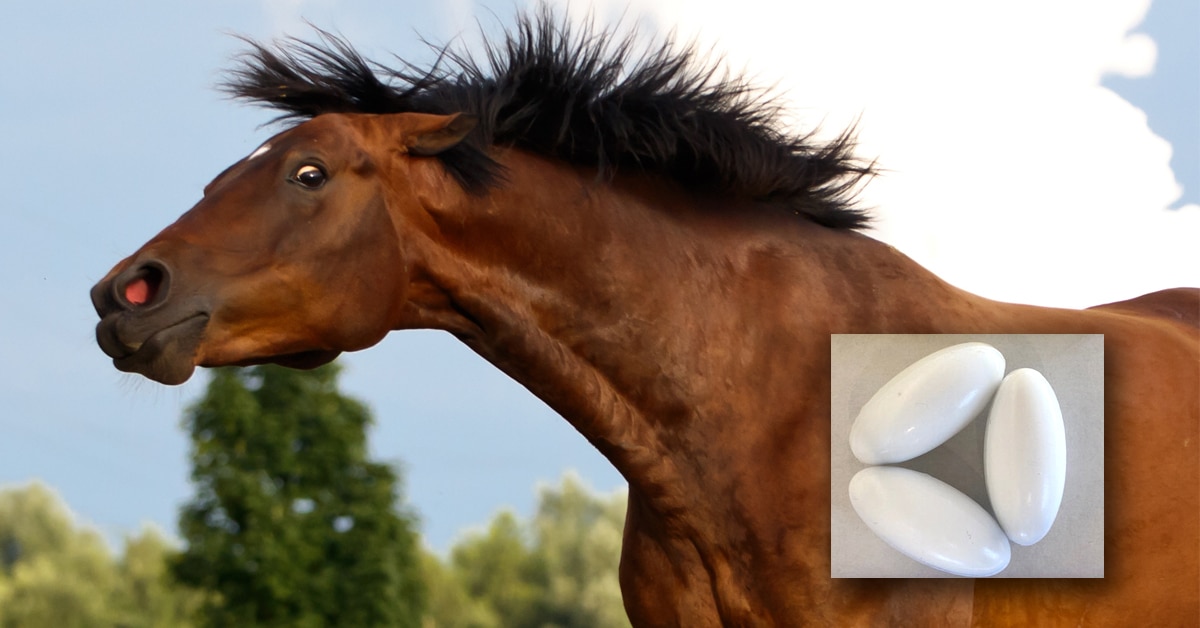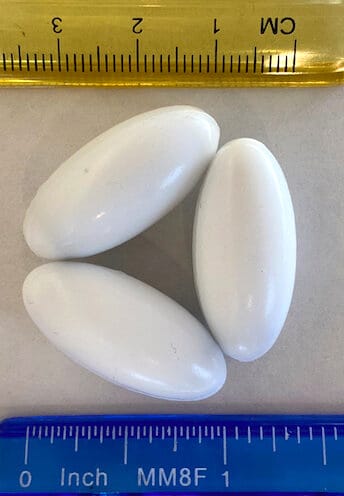Not every mare displays a change in behaviour when they’re in heat – but for those that do, sometimes the behaviour is so difficult it makes them impossible to ride or even handle.
For those mares, owners have for decades tried to find effective and safe solutions at keeping mares calm while in heat (also known as estrus, or being ‘in season’). The insertion of glass marbles into the uterus have been traditionally used, as it stimulated progesterone secretion and calmed behaviour by creating a false pregnancy. But glass marbles have an extremely low success rate while having the potential to cause many serious issues – including endometritis, infertility, and even abortions in cases where the mare was inadvertently bred by people believing the marble was gone.
Currently, the most common tactic is giving altrenogest (often referred to by the brand name Regu-Mate). It’s an oral medication that suppresses estrus in mares and thereby suppresses behavioural signs of heat – eliminating hormonal distractions and allowing performance horses to focus as they usually do. However, many people are reluctant to handle Regu-Mate, as repeated contact with the treatment can negatively affect the human female reproductive system, including cramping, disruption of the menstrual cycle, and even prolongation of pregnancy.
The perfect solution doesn’t yet exist, but a new innovation that recently hit the market is sparking promise among horse owners and veterinarians – enter the Pearl Pod.
How they work
Carlos Gradil, a veterinarian from the University of Massachusetts Amherst, developed the intrauterine device (the iUPOD®) that the Pearl Pod technology is based on. The Pearl Pod iUPOD is comprised of three elliptical plastic-coated magnets. The magnets are small (only about an inch long and half an inch wide) to allow for an easy insertion. Once inserted, the magnets self-assemble into a triangle shape, which prevents them from falling out – a frequent problem with glass marbles.
Similar to marbles, the Pearl Pod works by simulating pregnancy, causing the mare’s body to release more progesterone and preventing her from going into estrus. When it’s time to remove the Pearl Pod, the magnets are retrieved with a magnetic wand.
One of the major benefits of the Pearl Pod is that they can be detected in a mare by holding a hand-held metal detector to the mare’s abdomen – compared to glass marbles, which required skill to remove, and often remained in a mare without the owner’s knowledge (especially if the mare was bought and sold).
 Are Pearl Pods effective?
Are Pearl Pods effective?
Dr. Tracey Chenier, a veterinarian and researcher with the University of Guelph’s Ontario Veterinary College, currently teaches her veterinary students how to use the Pearl Pod, along with other estrus suppression options. She says that in her experience, the Pearl Pod seems to be effective – but the insertion process must be sterile, and if it’s not working, you should ensure that the device is removed.
The Pearl Pod has benefits, Dr. Chenier says, such as being easy to insert and not requiring daily administration. The long-term effects of using the product are currently unknown.
Who’s a good candidate for Pearl Pods?
When she’s assessing whether a mare would be a good candidate for a Pearl Pod, Dr. Chenier says she looks for “mares with no prior history of reproductive problems – healthy, maybe young mares, who just need a couple of months of estrus suppression.”
Notably, the Pearl Pod only creates about a 72-day extension of diestrus (the window when mares aren’t cycling), Dr. Chenier says. For most performance mares, that window of time may prove too restrictive.
“That’s pretty short-term when you’re looking at the length of a competition season,” Dr. Chenier says. “It’s not going to get somebody through the whole competition season.”
But the Pearl Pod isn’t intended for long-term use. “If the client is looking for a relatively short period of time, it might be a good option… if they need round-the-year estrus suppression, probably not,” says Dr. Chenier.
Hormonal mess to sweet, willing mare
Ellen Attridge’s mare Daisy was part of the study conducted by Dr. Gradil when the iUPOD was still under development. Attridge had bought the horse for her daughter in 2016, and once she started riding the horse, it became clear that Daisy had “some serious hormonal issues.”

The Pearl Pods are small, and easy to insert, remove and detect. (iupod.org photo)
“Literally half her cycles (12 days out of 24 cycles) she would be so tense, winking, and urinating – she was basically non-functional,” says Attridge. They had Daisy assessed for ovarian cysts, which came back negative. They also considered Regu-Mate, but Attridge didn’t want her daughter exposed to it. They were considering spaying Daisy when they were referred to Dr. Gradil for his study.
They trucked 11-year-old Daisy to UMass and met with Dr. Gradil. The iUPOD was still under development at that point, Attridge says, but “since the only other option was spaying, we figured we couldn’t lose trying it out.”
After IUD insertion, the difference in Daisy was night and day. “Her temperament improved, her body relaxed, and she became a sweet, willing mare,” Attridge says. Due to the parameters of the study, Dr. Gradil had to remove the IUD after six months. Since then, Attridge says Daisy’s hormonal temperament has returned somewhat, but her cycles are still barely noticeable, and she hasn’t reverted back to “the hormonal mess she once was.”
Attridge says that she would have liked to continue using the IUD for Daisy, and might look into it now that it’s commercially available. “I would definitely recommend it to anyone who has a mare with hormonal issues.”
Not the right fit for everyone
While the Pearl Pod may be beneficial for some horses, it’s not the right fit for every horse. Dr. Chenier counsels people to consider what behaviour they want to change – and whether it’s actually caused by being in heat.
“If you want to keep her calm for showing, that’s a different question than a mare who is poorly behaved during estrus and not rideable,” Dr. Chenier says.
“I think a lot of times, honestly, people blame ovaries and it’s [actually] training, poorly-fitting tack, lameness, the mare’s personality… Most of the cases we see, it has nothing to do with her cycle, and there’s other issues at play. You really have to address all those things first.”
Jo Harder from Ocala, Florida, tried the Pearl Pod for her mare Luna. Luna is an endurance horse and could be cranky when she was in season, sometimes refusing to move out and acting flirty if a gelding was nearby.
It cost Harder about $1,000, plus two half-day visits to the University of Florida, to get the Pearl Pod inserted for Luna. Once inserted, Harder says the benefits only lasted about three months, and then Luna reverted back to her usual self. At that point, Harder decided to have the Pearl Pod removed.
Although Harder says the veterinarians were “top-notch,” she thought that “Luna was very uncomfortable and likely in pain for about a week after both the insertion and removal surgery.”
“I wouldn’t do it again knowing what I know now,” Harder says. “I think that we just weren’t the ideal use case for the Pearl Pods.”
Future developments and long-term solutions
Future developments to the device could make it a better long-term option; for example, an IUD with hormones in it may lead to longer estrus suppression.
For the time being, however, Dr. Gradil says that “developing a progesterone-containing version of the iUPODs is not a priority… I like the idea that the devices, except for copper, are [natural and] drug-free.”
As a short-term solution, Dr. Chenier says that the Pearl Pod certainly holds promise. “But again, I think clients really need to talk to their veterinarians carefully about what behaviour they’re seeing. It’s also helpful if they can track the behaviour on a calendar to see if it matches a pattern, where estrus suppression might make sense.”
While there has been some difficulty keeping them in stock in Canada, veterinarians can order the Pearl Pod from their website. The device is only sold to veterinarians.


 Are Pearl Pods effective?
Are Pearl Pods effective?